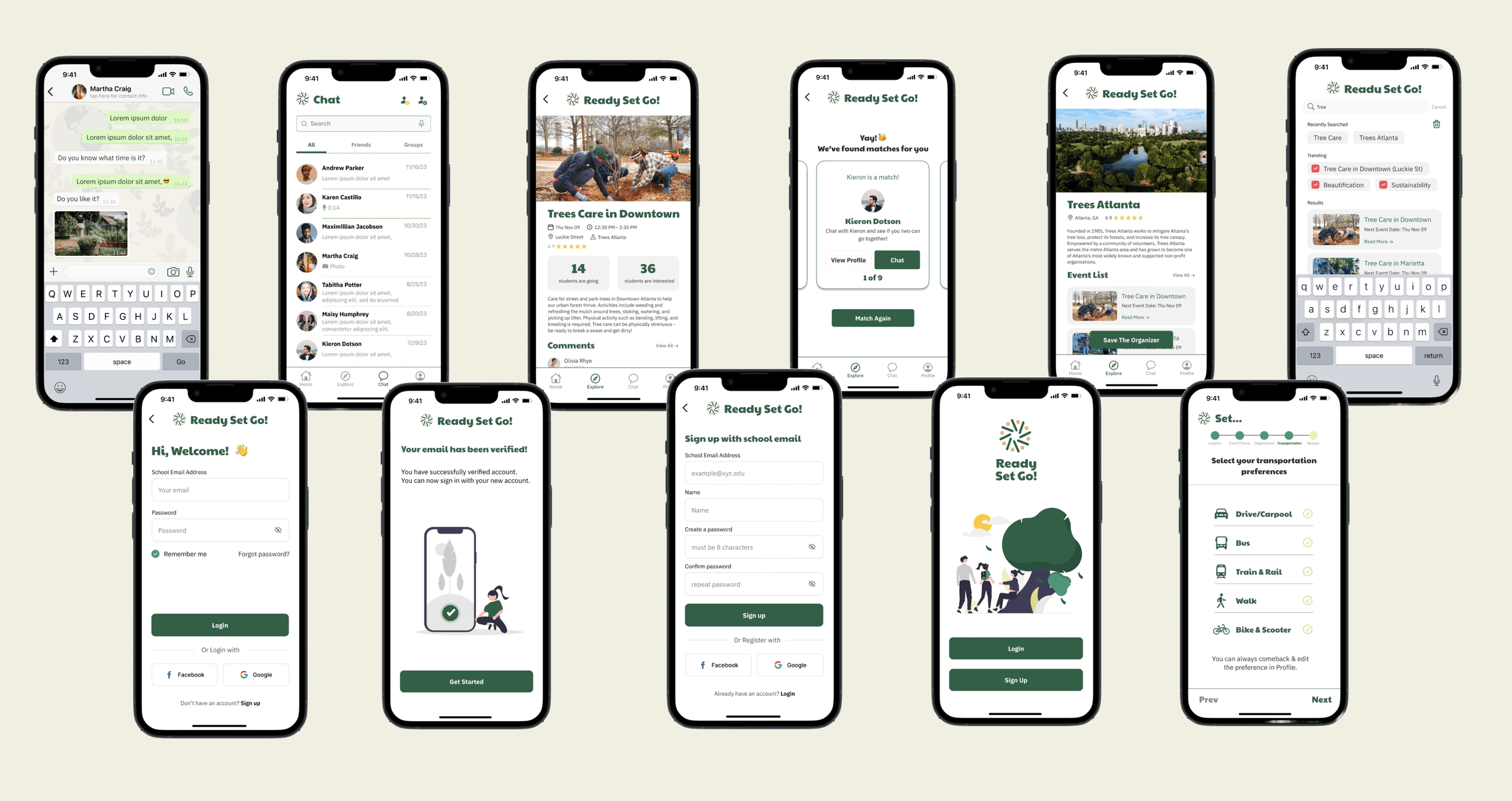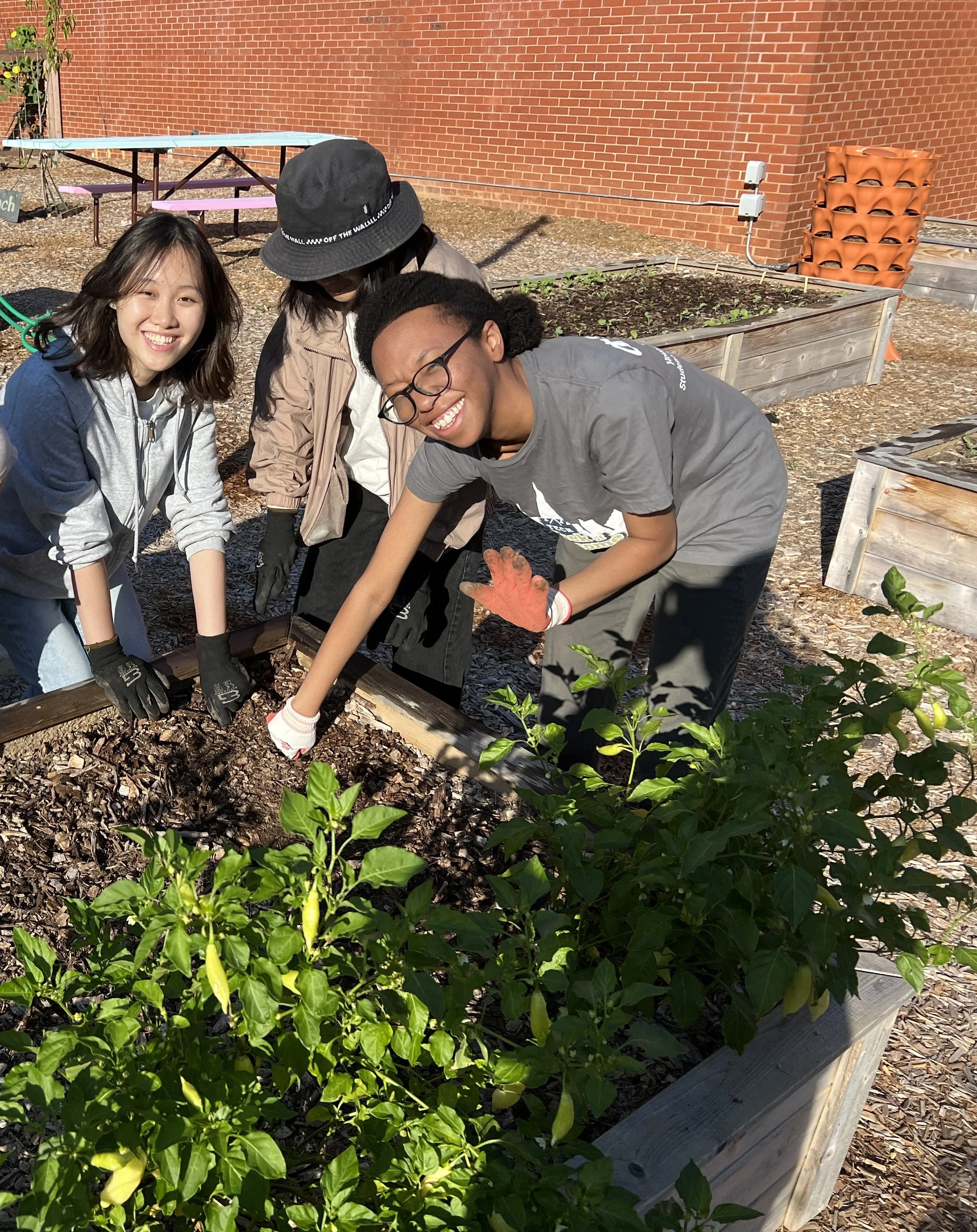Moving beyond screens: Connecting college students to inspire civic engagement

My Role
Lead UX Researcher
Project Management
The Team
4 UX Designers
Project Type
Course project for HCI Foundations Fall 2023
Methods
Literature Review
Heuristic Evaluations
Field Observations
Interviews
Task Analysis
Usability Testing
Timeline
15 weeks
From Social Distancing to Digital Activism: College Students’ Decline in In-Person Civic Engagement
While young adults actively engage in digital civic activities, including building their own virtual communities and sharing activism across social media, there is a notable lack of participation in offline events. Despite their confidence in making a difference in the world, research shows that the younger generation isn’t as actively involved in in-person civic activities within their local communities. The COVID-19 pandemic further exacerbated this decline in participation – more people found ways to get involved in activism from their devices, but in-person participation suffered.
Our team’s goal was to align online enthusiasm with in-person participation, focusing on young adults who are college students in environmental and sustainability events and initiatives.
Problem Statement
How might we bridge the gap between online and in-person engagement in environmental and sustainability events among college students?
Introducing our iOS mobile app design, Ready Set Go
Our team designed an iOS mobile app, Ready Set Go, to help college students connect with other students attending the same environmental and sustainability events. The goal of the app is to reduce the awkwardness of attending events alone and encourage in-person connections with other students who have similar interests.
The main features include:
Curate event recommendations based on the student’s location, interests, university groups they are members of, and transportation preferences
Matching and chat feature to help students connect and make lasting connections
Reward student’s with badges to maintain motivation to attend more events
My Role & Research Process
This project was completed as a part of my foundational course during my first semester at Georgia Tech. I took on the role as Lead UX Researcher and worked alongside 4 other UX Designers.
Given our short timeframe for the semester, I created a research plan with a schedule of the research goals, methods, and deliverables we could accomplish within the 15 weeks.
Leading the UX research efforts for the first time was a challenging (and fun) learning experience — there were many challenging moments that required continuous refinement and iteration. Throughout my case study, I also highlight insights on how I would approach the research differently in retrospect.
Research At a Glance: Our Timeline
September
Reviewed academic literature to gain domain knowledge on civic engagement challenges among college students, analyzed existing solutions using Heuristic Evaluations for opportunities, and identified gaps in addressing the decline in participation.
Deliverables:
Synthesized research into themes to identify unique participation barriers that college students face
Formulated research goals & questions to guide the team’s approach
Understanding the Problem Space
Field Studies, Pilot Interviews, & User + Stakeholder Interviews
October
Affinity Diagramming, Task Analysis & Ideation Workshops
On the ground observations and attendance at environmental and sustainability events and I created the interview guides, conducted pilot interviews to iterate on my interview scripts, and led semi-structured interviews with professors, event organizers, and students to gain a holistic view of the issue.
Led the affinity diagramming sessions with my team to synthesize our observational notes and interview data into themes; As a team, we created a task analysis and brainstormed potential design solutions in our ideation sessions.
Deliverables:
Identified 4 user pain-point areas to translate into design recommendations:
External Factors: time, weather and transportation impact attendance
Human Bonding: desire to create in-person connections
Incentives & Motivations: underlying drive to participate came from personal values
Event Accessibility: findability and accessibility of event information distributed lacked general audience appeal
November - December
Prototyping & Usability Testing
My team’s UX designers created the high-fidelity prototype based on our design recommendations and I led the usability testing sessions. We then distributed user feedback surveys using Likert scale style questions to rate and calculate the System Usability Score (SUS).
Deliverables:
Overall usability of our prototype was rated well, with an average SUS score from our 4 users was 86.25
While users seemed happy with the usability, I synthesized the user feedback from the usability testing and “think-aloud” to develop takeaways for design improvement
A Deep Dive into the Process
A tour through our research methods
Creating Team Alignment & Laying out our Assumptions
Civic engagement is a complex and multi-faceted concept. Researchers don’t have a single, universally agreed upon definition for it — civic engagement can be expressed in different ways for different people.
So before diving into the UX research, I held a meeting with my team and we had a open discussion on what we assumed civic engagement was and what the experts say. This helped create alignment amongst the team. We defined civic engagement as actions and activities that people participate in with the goal of making a difference and positive impact within their communities.
Civic engagement can also have different levels (e.g. passive engagement such as reading the news and active engagement like collecting recyclables at your local library). I used FigJam and mapped out the relationships between low vs. high and online vs. offline civic engagement.
With a shared perspective and definition, our team was ready to move forward to scoping our problem and user group.
Constraints & Considerations
We refined our target user group as college students, ages 21-24. Next, we took a deep dive into academic literature on studies done regarding civic engagement and young adults that highlighted unique characteristics of our user group that could impact their participation in civic engagement including civic literacy and socioeconomic background.
We also analyzed over 5 existing solutions and organizations, including Vote.org, Be My Eyes, and Hands On Atlanta, to discover the different opportunities and gaps that exist within the status quo.
Our research revealed that by encouraging more in-person participation, there were considerations we had to keep in mind to ensure our designs remained accessible and inclusive.
Considerations for in-person events
-

Transportation
In-person events often require transportation (unlike digital spaces where you can attend virtually). We would need to consider barriers for some students who might not have readily available transportation access.
-

Accessibility
In-person events might also need to include physical accommodations to be inclusive for people with a variety of needs. We would need to ensure our design takes into account how to make sure participants are aware and informed about their accessibility options.
-

Hybrid Participation
Research shows that young adults enjoy “hybrid activism” and believe that online and offline engagement complement one another. We would need to keep this model in mind and leverage online tools to help encourage in-person participation.
Research Goals
After our literature review, we defined our high-level research objectives:
Learn more about the unique barriers that might prevent college students from attending in-person events
Assess the findability and accessibility of environmental and sustainability events, specifically university initiatives targeted to college students
Determine to what extent awareness and civic literacy among college students impacts their attendance at environmental and sustainability events
Understand the impact attending an in-person event in a group vs. alone has on student’s participation and motivation
Field Observations
We conducted field observations to gain an insider's look on environmental and sustainability events. Our goal was to find out the different methods of outreach used by event organizers, understand the different levels of engagement and accessibility of the activities, and get a sense of the atmosphere and community from the event organizers and the participants.
We attended on-campus environmental and sustainability events including Students Organizing for Sustainability Community Garden and Regional Centre of Expertise (RCE) Americas Conference For Youth Engagement.
During the events, we spoke to professors, event organizers, and students about their experiences including how they discovered the event and their thoughts on the activities. Through our conversations and observation notes, we discovered there were significant opportunities for us to help improve the findability of the events and outreach.
Research Insight
Students and organizers expressed concern that in-person events are hard to discover, so outreach could be improved to appeal to a wider net of students.
An Educator’s Perspective
I created interview guides for both our stakeholders and users. I believed it was important for us to interview both our stakeholders and users because their needs and perspectives might be misaligned.
For our stakeholders, we conducted semi-structured interviews with 1 professor and 2 event organizers within the environmental and sustainability domain area.
In the stakeholder interview guide, I focused on the following key areas:
Event hosting experience and outreach methods
Perspectives on student participation and motivation for engagement
Accessibility and findability of events
General recommendations on how to make in-person events appealing to students
While educators and organizers appreciated students' passion for making a difference in the world, they expressed concerns about the barriers that might cause students to disengage in environmental and sustainability initiatives.
Educators & Organizers Pain Points
-

Insufficient Civic Literacy
Students might lack civic knowledge and awareness about environmental and sustainability issues (e.g., in the U.S., a curriculum in environmental and sustainability is not a high school requirement). And if students aren’t aware of the problems, they don’t know to show up to help solve them.
-

Difficulty Visualizing Impact
Educators and organizers found it challenging to help students visualize the issues' personal impact on their lives. So, they were at a loss on how to combat student apathy.
-

Lack of Time
While juggling their busy course schedules and commitments, students might not have the time to devote to participating in in-person events. And since it’s not typically embedded in the curriculum, students need to find time outside of their classes. So, student follow-through and commitment are generally low.
A Student’s Perspective
Next, I created the user interview guides and conducted pilot testing of the questions. For example, I found that the heavier questions at the start of the interview were a bit intimidating (e.g., asking about their awareness and ideas surrounding environmental and sustainability issues).
After a few rounds of interview script iterations amongst the team, we recruited students via on-campus social channels like Slack. We conducted 3 semi-structured user interviews with college students with varying experiences attending environmental and sustainability events (e.g., some had gone once, while others went many times).
We aimed to uncover the barriers preventing college students from attending and how we might better motivate them. To achieve this, I focused the user interview questions on the following key areas:
Awareness and education of environmental and sustainability issues
Motivations and levels of interest in attending
Unique barriers that prevent them from participating
Online and offline event experiences
Physical ability
General recommendations for how to motivate students to engage more in person
What would I do differently?
I think coupling the user interviews with surveys would have been powerful here — surveys are low-cost, easy to distribute, and would provide me with a mix of qualitative and quantitative data. Surveys would have helped me answer early on the WHAT question of what students’ self-report as potential barriers for participating. Given the limited time, I chose to focus my efforts on doing in-depth interviews to uncover the WHY of student disengagement. If I could rewind the clock, I would have distributed surveys in the discovery phase to help better inform my interview questions.
Finding Themes & Patterns
To synthesize our interview data, we conducted a team affinity diagramming session. After assembling our stickies, I then distilled the user pain points into 4 main themes. We then created a task analysis to further visualize the pain points and process of how student’s discover events and plan of how to get to them.
Based our themes, we created a total of 8 design recommendations for our design. We decided to move forward with supporting 4 design requirements within our design solution that I’ve highlighted below.
College Student Pain Points
-

External Factors
Time, weather conditions, and transportation impacted whether students’ would commit to attending in-person events.
-

Human Bonding
Students found that in-person events were oftentimes awkward or lonely when attending alone, and expressed interest in going with a group. They also felt in-person social-interactions were more meaningful and engaging than online.
-

Incentives & Motivations
Students felt more motivated to attend events aligned with their personal beliefs. But they found many events demotivating because they had trouble visualizing the impact they wre making on the world.
-

Findability & Accessibility
Students’ felt events promotions were not readily available to general students. They also expressed interests in having events be geared towards and accessible to a general audience, without requiring any experience in environment or sustainability.
Design Recommendations
-

Enhance Social Interaction
Our design should facilitate and encourage meaningful user connections and social-interactions.
-

Enhance Findability
Our design should include easy to use navigation, content search, and usability.
-

Use Familiar Expressions & Systems
Our design should support familiar iconography, symbols, and functionality for ease of use and a low learning curve.
-

Incorporate Positive Reinforcement & Feedback
Our design should include a award system to maintain user motivation.
Ideating & Prototyping
We used various brainstorming and ideation techniques including Rapid Ideation, Moodboards, Metaphors, and Affinity Mapping to generate design ideas. Our ideas ranged from campus mobile applications to personalized avatars and reward systems.
The team decided to move forward with designing a mobile app that would help connect other college students with each other.
The goal was to create a mobile app that would encourage students to attend environmental and sustainability events by helping them find other students to attend with, make the process of finding events easier, and earn rewards to stay motivated.
Usability Testing & Results
While the UX designers on my team worked on the interactive prototype, I created our Usability Testing tasks to test with our users and we conducted testing with 4 college students. In the usability testing procedure, I asked users “think aloud” and complete the 2 main tasks:
Completing sign-up and onboarding
Explore events page, find a particular event, and then find a student match to attend the event with
I then asked users to complete a standard System Usability Scale (SUS) questionnaire as a quick way to gauge the their general opinion on the prototype’s usability. And to close, I asked open-ended feedback questions to get their overall impression of the experience.
While users raised issues with some of the visual design (e.g. hierarchy, too small font and icon sizes, color contrast concerns etc.), the average SUS score from our users was 86.25, which indicates they thought the design had overall good usability.
Reflecting on the Journey
Me and the team planting beets at the Community Garden event during field observations.
Learning the UX Research process
As my first time leading the UX Research, I learned a lot about conducting data-driven research and making decisions based on the evidence that we gathered. And by working on an end-to-end design, I learned how to test and evaluate the usability of a design.
Narrow the project scope as early as possible
Our team would have been able to dive deeper into the research regarding environmental and sustainability events had we scoped our problem early on.
Recruit more users
Given our class schedules, it was difficult for us to balance the time between this project and our other competing commitments. As a result, we weren’t able to recruit as many users as we would have liked. If I could go back, using surveys would have been a great opportunity to help with screening and recruitment of more users to include in our research.
Attribution: Icons used in this case study were sourced from Freepik’s Special Lineal Collection.








